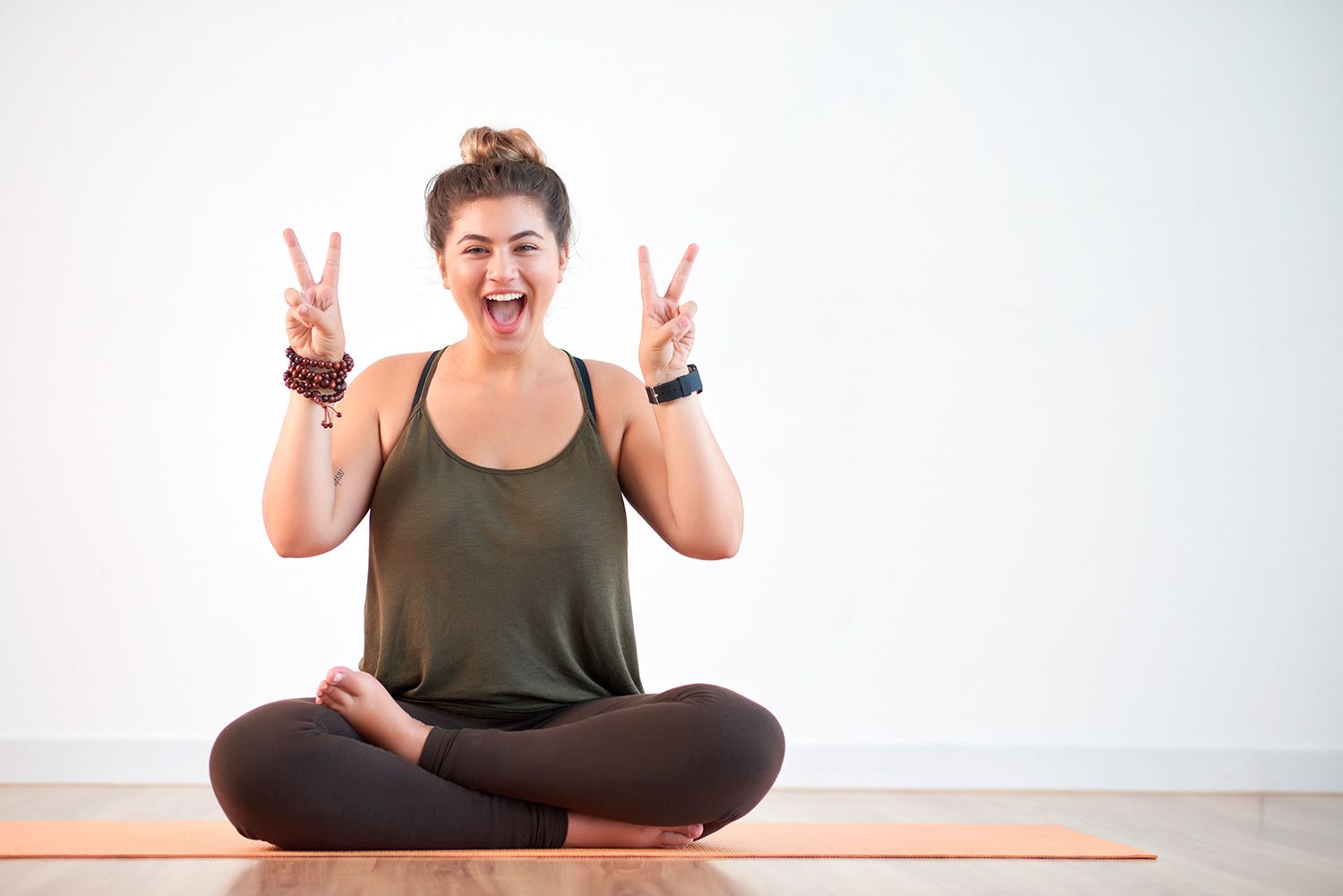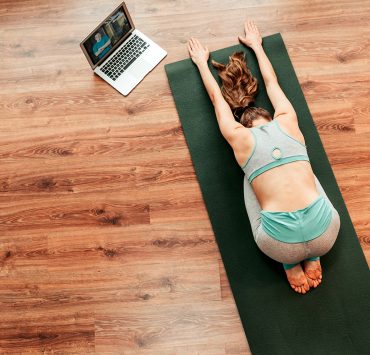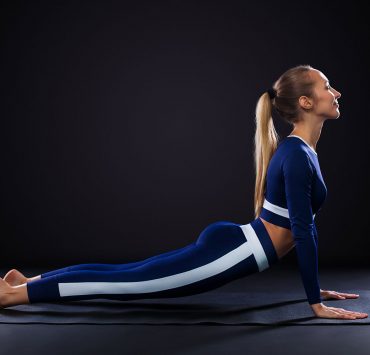
A graduate of Arizona State University, Nicole Baker is a…
Social media perpetuates the myth that yoga is only for the young and the thin. Additionally, when yoga is marketed towards plus size women the media often assume that because they have curvier bodies that they cannot have a powerful yoga practice and are stuck with restorative or gentle postures. While relaxing postures feel great, being plus-sized doesn’t mean that they can’t have a physically challenging practice. Practitioners of yoga know that yoga is truly for everybody regardless of age race ability gender or size. We will outline some yoga postures to get started out with. They can either be practiced and the full expression of the posture but we will also include some modifications that may or may not be needed for plus size women.
Getting Started With Yoga

To get started with a yoga practice, there are a few concepts to learn to help maintain a practice. The first is to practice ahimsa which is Sanskrit for do no harm. Ahimsa is one of the foundational concepts to practice yoga. While this can apply to our everyday lifestyles, it also applies to asana practice also known as postures. When practicing yoga, it is important to not push so hard through the postures to the point of hurting ourselves. By being kind and compassionate towards ourselves we can have a long and prosperous practice.
Another way to get started is to befriend props and modifications. While the perfect triangle posture on glossy magazine covers or Instagram, the full expression of the postures is not accessible to everyone’s body type. Often trying to mimic the perfect posture without adapting to the individual’s constitution leads to misalignment. Modifications and props can help make postures accessible to everyone in a way that’s appropriate for their body so they can get the most out of the posture. For plus size women specifically, some useful props may include setting up their mat near a wall or having a chair nearby as well as blocks and a blanket.
Finally, practicing on a regular basis will help practitioners get all of the benefits of yoga. 10 minutes of yoga, 5 days a week will help develop healthy habits versus a one-hour yoga class every now and then.
General Modifications And Contraindications

There is no one size fits all approach for plus sized women practicing yoga. However, there are a few general modifications that can work great for curvier bodies.
Often yoga requires students to fold forward at the waist and if there is a little bit of extra weight stored near the belly it could be a little bit challenging. As a general rule, if the belly is in the way during forward bends but the practitioner can go a little bit deeper they can just take their feet out wider. This modification is often true for both standing and seated postures.
For postures that require going on the hands and knees such as table top or sunbird, placing a blanket underneath the knees can help take pressure off the knees.
Salamba Balanasana — Child’s Pose

Child’s pose has a great posture for any practice and often one of the first asanas people learn. Child’s pose is a place of rest and can be very calming on the mind and the body.
To start, come onto hands and knees and bring the knees and feet together and release the sit bones towards the heels. Lengthen the neck and let the forehead lower down towards the mat or a block while extending the arms forward but still keeping them in line with the shoulders. If bringing the knees and feet together are challenging, create space for the body by bringing the knees out wider while still letting the toast hutch. If there’s a little bit more space is needed, place the forehead on top of the block instead of the mat.
Ashwa Sanchalasana — Low Lunge Pose

Low lunge can help stretch the hips while building strength and balance.
Get started by coming on to all fours in table top. Then bring the right foot forward and between the hands. Keep the right knee above the right ankle, avoid overextending the knee by keeping the toes more towards the front of the mat. Extend the left leg farther back as if trying to get the knee away from the glutes. Take the gaze forward while relaxing the shoulders and opening up the chest. Hold for several breaths before repeating on the opposite side
A few challenges that may occur is having space for the body specifically the belly. If this was an issue simply widen the stance by taking the front foot more towards the side edge of the mat. If the hands are having a tough time staying on the floor place them on top of blocks. If the back knee is aggravated from pressure, place a blanket underneath the knee
Phalakasana — Plank Pose

Plank pose is found in many yoga practices due to its inclusion in sun salutations and its ability to strengthen and tone the entire body. Starting on all fours or end table top stop the feet towards the back of the mat keeping them hip distance apart. Lift the knees and create a downward slope from the back of the neck all the way down towards the hills engaged in the abdominal broadening the chest and activating the legs.
If the full expression of the postures challenging, there are several modifications to take. If there’s too much pressure on the wrist, start by pressing the elbows and forearms into the mat so you have a more solid base. The whole body will still need to be engaged. Another modification it’s just simply lower than knees down. For a little bit more balance and stability, the feet can also step out wider
Bhujangasana — Cobra Pose

Cobra pose is excellent to help stretch the lower back.
To start, come on to the belly. Press the hands onto the mat right underneath the shoulders with the elbows pointing towards the back of the room. Gently lift the head and shoulders off of the mat and the chest if possible. Take the gaze forward, lifting the head out of the collarbones while relaxing the shoulders downward.
For cobra, there are a few modifications that can help find a little bit more comfort. If it feels like there’s too much pressure on the hips place a blanket underneath the hips for some extra padding. If the lower back feels aggravated takes a feet out a little bit wider or keep the elbows shoulder distance apart but bring them more towards the front of the mat.
Virabhadrasana II — Warrior II Pose

Another strengthening posture, Warrior 2 helps strengthen the legs and the arms while opening up the chest in the hips.
To start, come into mountain pose facing the long side of the mat. Step the feet out wide with the toes facing the long side of the mat. Reach the arms out into a T with the palms facing downward. Try to widen the stance so the outsides of the feet are underneath the wrists. Rotate the right toes so they are facing the short side of the mat. Bend the right knee 45 to 90 degrees and externally rotate the thought so that the knee is pointing in the same direction as the toes. Take the gaze over the right middle finger. Hold for several breaths before repeating on the left side.
Trikonasana — Triangle Pose

Triangle pose helps stretch the body from the shoulders all the way down to the hips and thighs.
Start by coming into mountain pose facing the long sides of the mat. Steps the feet out wide. Rotate the right toes so they’re facing the short side of the mat. Extend the arms into a “T” with a palms facing the long side of the mat. Hinge at the waist so the right hand reaches downward while the left hand reaches up towards the sky. Rotate the left hip externally so the hips are facing the same direction.Hold for several breaths before repeating on the opposite side.
To modify this posture, place the bottom hand on top of a block or a chair to help keep the alignment of the body.
5 Pointed Star
Five pointed star helps strengthen the body in a gentle way.
Start in mountain toes facing the long side of the mat. Step the feet out wide and then reach the arms out into a “T” with a palms facing down. Try to step the feet out as wide as the wrists. Like mountain pose, allow the tailbone should be neutral and the legs should be activated while rooting down into the feet. Lengthen through the spine Hold for several breaths
Utkata Konasana — Goddess Pose

Goddess pose helps strengthen the whole body particularly the legs. It can easily be modified by holding the pose for longer or shorter periods of time.
To start, come to five pointed star and then rotate the toes 45° outwards. Bend to the elbows with a palms facing forward as if making a football goal. With the tailbone neutral and shoulders above the hips, bend the knees and hold the posture for several breaths increasing the amount of breaths to make the posture more challenging.
Malasana — Yoga Squat Pose

Squat helps open up the hips and excellent to bring the energy down in a practice from standing postures down towards the floor.
To start, take the feet out a little wider than hip distance apart with the toes either facing forward or towards the corners of the mat. Keeping the spine neutral and a feet planted, bend the knees and start lowering the glutes downwards a few inches above the floor. Bring the hands and prayer.
To modify, this can be done against the wall to help have a little bit more balance. Additionally sitting on top of blocks can help make the posture more comfortable if the student needs to be a little bit higher off of the floor while they are working on their flexibility and balance.
Baddha Konasana — Cobbler’s Pose

Cobbler’s pose helps open up the hips and the groin area and can be a very relaxing posture.
start in a seated position and bring the soles of the feet together. Lower the knees to their respective sides of the floor. Ensure the pelvis is neutral while lengthening the spine.
To help with tighter hips, sitting on top of a folded blanket or a block can help create a little bit more space to loosen up the hips and sit more comfortably. Blocks can also be placed underneath the outsides of the lefs for more support.
Ananda Balasana — Happy Baby Pose

Happy baby is a great hip opener.
To start, bring knees the knees into the chest and then separate the knees so they are just a little bit wider than the rib cage. Separate the feet so they stack above their respective knees. Grab the outside of the feet with the hands gently bring in the knees closer down towards the floor while the feet remain stacked above the knees. Hold for several breaths.
To modify this posture that strap or belt can be placed around the arches of the feet gently pulling on each side of the strap to bring the knees closer towards the floor.
Savasana — Corpse Pose

Often touted as the most important posture savasana helps ground us into the present moment.
Lying on the back gently let the feet release out to the sides. Let the arms come along the side of the body palms facing up. Allow the eyes to close. Lying here for several minutes, try to stay present in the moment and guiding the awareness back into the breath anytime but the mind begins to wander or ruminate.
Conclusion
Yoga is available to everybody regardless of their body shape or size. Plus size women can definitely enjoy a full yoga practice by either doing the full expression of the postures or modifying it to their specific needs.
What's Your Reaction?
A graduate of Arizona State University, Nicole Baker is a force to be reckoned with in the realm of health and wellness. She studied behavioral health, which propelled her desire to live holistically and share her knowledge with other like-minded individuals.














